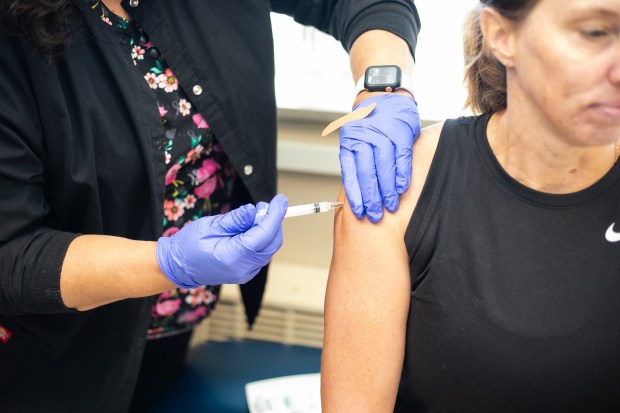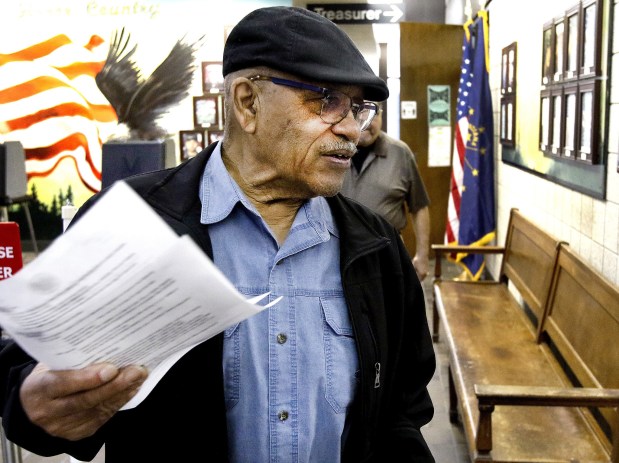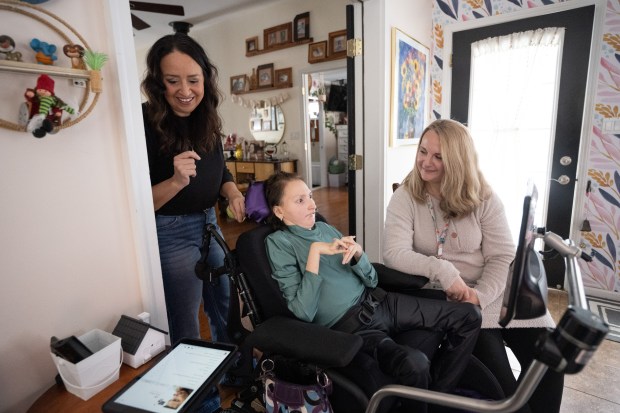As legislators meet Wednesday in Indianapolis to start a budget-focused session, a December revenue forecast projected the state’s minimal fiscal growth would go toward Medicaid expenditures.
As a budget year, legislators will spend the 2025 legislative session drafting a two-year budget and determine how to spend $44 billion for schools, health insurance programs and infrastructure, among other fiscal issues. Legislators will also have to reckon with funding the Health First Indiana program and property taxes.
Medicaid services are a particular focus amid an inaccurate projection by $984 million for its Medicaid expenditure forecast in April 2023. The missed projection was the result of state budget reversions and unanticipated growth of services for aging and disabled residents.
“Our decision cannot come light. We are walking into a difficult budget session,” Sen. David Niezgodski, D-South Bend, said during a Dec. 17 Senate Budget Committee meeting.
Crown Point resident Mimi Burke, on left, and her daughter Sophia, who has Rett Syndrome, work with Crown Point Schools language pathologist Adrian Herrenbruck during a speech therapy session on Thursday, January 25, 2024. (Kyle Telechan for the Post-Tribune)
Medicaid
The Family and Social Services Administration, which oversees Medicaid in the state, projected for the upcoming budget a cost containment of $996.7 million in expenditures or $348.1 million in appropriation avoidance with three initiatives, said Cora Steinmetz, Medicaid Director for FSSA.
The first would be a reimbursement initiative, which removed a July 2024 rate index from Medicaid home- and community-based services, dental, home health, applied behavioral analysis therapy, and no changes to durable and home medical equipment reimbursements, she said.
For home- and community-based services enrollment, FSSA limited slot growth on the aged and disabled waiver program and paused expedited waiver eligibility, Steinmetz said.
Under HCBS services, FSSA transitioned caregiving by legally responsible individuals to structured family caregiving, which aligns with approved waiver authority, Steinmetz said. The department also reviewed its most-used outlier waiver service plans and enhanced compliance with waiver service definitions including home modifications, vehicle modifications and specialized medical equipment, she said.
From January 2020 to April 2023, Medicaid grew by approximately 772,000 people from 1.49 million to 2.26 million, respectively, Steinmetz said. Much of that was due to Medicaid’s continuous enrollment policy during the pandemic, which ended in April 2023. Medicaid declined to 2.03 million as of May 2024, she said.
The cost containment, and decrease in Medicaid participants, will result in FSSA requesting fewer dollars from the general fund, Steinmetz said. FSSA has been working toward improving the forecast process since the inaccurate forecast, she said.
“There has not been a day that has gone by since the December 2023 Medicaid forecast where I, many others, have not committed ourselves to ensuring that the accuracy and the reliability of the forecast is improved,” Steinmetz said.
Carrie Thornberry, left, administers a set of vaccine injections for Teresa Huisenga of Highland at the Lake County Health Department’s Immunization Clinic, in Crown Point on Thursday, Aug. 31, 2023. (Vincent D. Johnson/for the Post-Tribune).
Health First Indiana
In 2024, the Health First Indiana initiative kicked off to address Indiana’s low public health metrics, including immunization, maternal mortality, obesity and diabetes, Lindsay Weaver, Commissioner of the Indiana Department of Health, said during the December committee hearing.
In the last century, the average lifespan of someone living in the U.S. has increased by more than 30 years, and 25 of those years are attributed to advances in public health, Weaver said. But, in Indiana, life expectancy has decreased over the last decade, she said.
“Indiana had constantly scored poorly in health metrics, often ranking toward the bottom of the nation. We’ve seen rising health care costs, including medical care spending on preventable treatments,” Weaver said.
The first year of the program included 86 out of 92 Indiana counties opting into $75 million in state funding to improve health metrics, Weaver said. About 80% of the funds went toward preventable services, like chronic disease prevention, immunization and maternal and child health, she said, while the remaining funds went toward regulatory services like environmental public health.
In 2025, all 92 counties have opted in for $150 million in Health First Indiana funding, Weaver said.
“We will of course be working with all of you and the incoming administration on figuring out what that correct number to request is in the coming years,” Weaver said.

Percy Jones of Gary talks about paying his property taxes at the Lake County Government Center on Tuesday, April 4, 2023. Property tax bills are out and people are none to happy. A steady stream of taxpayers popped into the treasurer’s office to pay their bills. (John Smierciak/Post-Tribune)
Property taxes
Matt Greller, the CEO of Accelerate Indiana Municipalities, said the organization advocates on behalf of cities and towns during legislative sessions and monitors between 200 to 300 bills that could have an impact.
For the 2025 session, Greller said AIM will look for bills that address property taxes, road funding and the budget as a whole.
Governor-elect Mike Braun has proposed a property tax proposal that would freeze future property tax increases by capping the increase in tax bills at 2% for seniors, low-income residents and families with children under the age of 18 and 3% for all other taxpayers.
Braun suggested overhauling the homestead deduction to allow every homeowner with an assessed value of more than $125,000 to deduct 60% of their home’s assessed value from their tax bill. Those with an assessed value below $125,000 would be allowed to take the standard deduction of $48,000 in addition to a 60% supplemental deduction, according to the proposal.
The proposal states the tax cut would result in a 21% reduction in the average homeowner tax bill and result in a 39% reduction in the average tax bill for homes worth $80,000.
But property taxes are the single most important revenue stream for cities and towns, Greller said, which pay for police, fire, parks, trails, snow plowing services and so much more. Property taxes make up between 40% to 70% of municipal budgets, he said.
“Anytime you talk about property taxes we immediately become concerned about what impact that could have on our ability to provide those services,” Greller said.
Capping the property tax increase would be the most impactful portion of Braun’s proposal, Greller said, because it would mean local governments would struggle to grow a property tax base which would make it harder to provide services.
Braun’s proposal to increase the homestead deduction “would certainly cause some shifts and revenue losses for local governments,” Greller said.
“We’d have some concerns about and have to proceed cautiously there,” Greller said.
Another property tax component, Greller said, is business personal property tax, or the tax on equipment, which is a big part of property tax funding that local governments receive. Some people have said the business personal property tax is an antiquated tax, Greller said.
“What is important is that is a significant tax part of our property tax revenue and any significant changes or cuts to that process or system would have to be closely examined as well,” Greller said.
Some legislators have stated they would like to look into the municipal growth quotient, which is the rate at which taxes can grow every year, to make it more regionally based as opposed to the current, complicated formula, Greller said.
Greller said the outcome of changing the municipal growth quotient isn’t clear, but AIM will be reviewing legislation that proposes any changes.
If the legislature changes the property tax system, Greller said it would have to require a plan to fund municipal services. Greller said legislators have discussed allowing municipalities over a certain population to adopt an income tax to make up for any shifts in property taxes.
“That could be a solution, but we’d have to make sure that the ability to drive income tax revenue would adequately replace whatever is lost from a property tax standpoint,” Greller said. “At the end of the day, it’s a very interwoven system, so just because you’re reducing something over here on the right side, does not mean it results in no increase on the left side if you’re looking at it from a basic standpoint.”
Over the last six to 10 years, Greller said Indiana has done a great job allocating funds, which come from the state gas tax, to municipalities to improve roads. As cars become more fuel efficient or electric, Greller said legislators have to find a way to maintain the state’s infrastructure as the revenue stream begins to fade away.
“We’re a long way away from that actually happening, but we’re certainly headed down that path,” Greller said. “We’ve got to look at it in a way that includes local government, state government, make sure that interstates, state roads and local roads, streets and bridges are accounted for.”
For local governments, Greller said the Community Crossings Grant program, a state-matching grant for infrastructure projects from the state gas tax, has helped municipalities develop and redevelop. Greller said the legislature will likely discuss increasing the cap on the grants over the next few years.
On the budget as a whole, the state’s READI program, a state matching grant for local public, private and philanthropic projects, will likely be on the chopping block, Greller said. Over the last two budget cycles, Greller said the legislature has approved $500 million toward the READI program, he said.
“The idea of a third round of READI funding is probably very much in question this budget cycle, so we’ll see how that plays out, but that would probably be, from a state budget standpoint, the number one issue for cities and towns,” Greller said.
akukulka@post-trib.com





